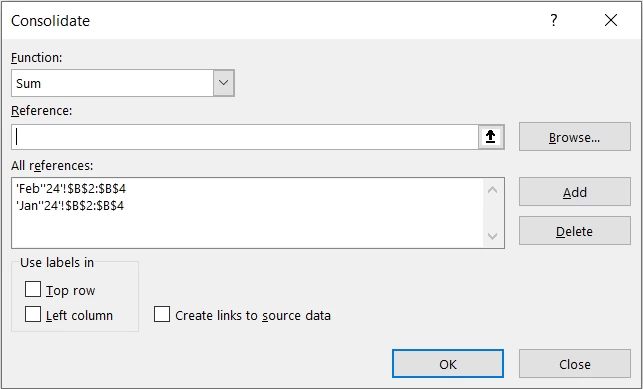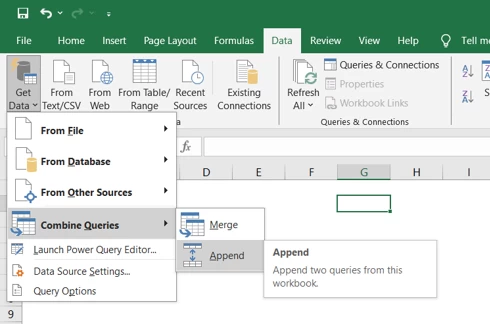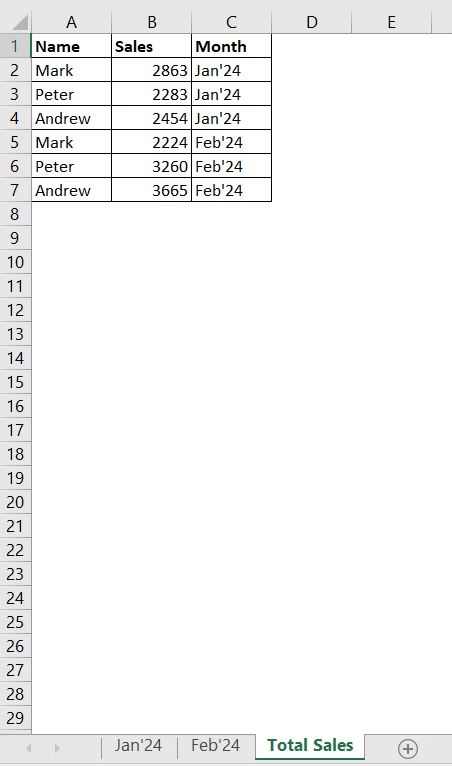How to Combine All Sheets in Excel? You can save time and effort while working with Excel files if you know how to combine, separate, and use data. Often, users find themselves in trouble when dealing with multiple sheets within a single workbook. This can complicate data interpretation and analysis.
Fortunately, Excel offers many methods to combine all sheets, streamlining the process and enhancing efficiency. In this article, we will explore different approaches to combining multiple sheets in Excel, highlighting their advantages and empowering users to make informed decisions in their data management endeavours.
Advantages of Combining All Sheets in Excel
1. Improved Data Accessibility
Consolidating data from multiple sheets into a single location enhances accessibility, allowing users to quickly locate and reference information without navigating through numerous tabs.
2. Enhanced Data Analysis
A unified dataset facilitates comprehensive data analysis by providing a holistic view of information. Analyzing consolidated data enables users to identify trends, patterns, and insights that may not be apparent when examining individual sheets separately.
3. Simplified Reporting
Creating reports and presentations becomes more efficient when working with consolidated data. By centralizing information, users can easily generate reports, charts, and graphs that accurately reflect the complete dataset, improving communication and decision-making processes.
4. Reduced Errors
Consolidating data eliminates the risk of discrepancies and errors that may arise from manually combining information from multiple sources. By automating the consolidation process, users minimize the likelihood of data inconsistencies and ensure data integrity.
[4] Ways to Combine Excel Files into One Excel File
Here are the complete steps for different methods to merge multiple sheets into one file.
1. Using Consolidate Function:
Step 1: Open your Excel file containing multiple sheets.
Step 2: Navigate to the sheet where you want to consolidate the data.
Step 3: Select a cell where you want the consolidated data to begin.
Step 4: Go to the “Data” tab on the Excel ribbon.
Step 5: Click on the “Consolidate” button in the “Data Tools” group.
Step 6: In the “Consolidate” dialogue box, specify the ranges or references from the sheets you want to combine.

Step 7: Choose the type of consolidation function (such as sum, average, count, etc.) you want to apply.
Step 8: Select any additional options as needed.
Step 9: Tap on “OK” to consolidate the data.
Example:
Excel Sheet [Jan’24]:
| Name | Sales |
|---|---|
| Mark | 2,863 |
| Peter | 2,283 |
| Andrew | 2,454 |
Excel Sheet [Feb’24]:
| Name | Sales |
|---|---|
| Mark | 2,224 |
| Peter | 3,260 |
| Andrew | 3,665 |
Output:
| Name | Total Sales |
|---|---|
| Mark | 5,087 |
| Peter | 5,543 |
| Andrew | 6,119 |
2. Manual Copy-Paste:
Step 1: Open your Excel workbook containing multiple sheets.
Step 2: Navigate to the first sheet from which you want to copy data.
Step 3: Select the range of cells containing the data you want to consolidate.
Step 4: Right-click on the selected range and choose “Copy” from the context menu, or press Ctrl + C.
Step 5: Switch to the sheet where you want to consolidate the data.
Step 6: Select a cell where you want the copied data to begin.
Step 7: Right-click on the selected cell and choose “Paste” from the context menu, or press Ctrl + V.
Step 8: Repeat steps 2-7 for each sheet you want to consolidate, pasting the data into the same master sheet.
3. Power Query (Get & Transform):
Step 1: Open your Excel workbook containing multiple sheets.
Step 2: Move the cursor to the “Data” tab on the Excel ribbon.
Step 3: Click on the “Get Data” button and choose “Combine Queries” or “Combine Sheets” depending on your Excel version.

Step 4: Select “Append Queries” or “Merge Queries” depending on your data consolidation needs.
Step 5: Follow the prompts to select the sheets and configure the merging options.
Step 6: Apply any necessary transformations or adjustments to the merged data.
Step 7: Click “Close & Load” to import the integrated data into a new worksheet or existing worksheet.
4. Using VBA Macros:
Step 1: Press Alt + F11 to open the Visual Basic for Applications (VBA) editor.
Step 2: In the VBA editor, navigate to “Insert” > “Module” to insert a new module.
Step 3: Copy and paste the VBA code for integrating sheets into the module.
Sub Consolidate_Sheets()
Dim WS_EACH_SHEET As Worksheet
Dim WS_TOTAL_SALES As Worksheet
Dim L_LAST_ROW_WS_EACH_SHEET As Long
Dim L_LAST_ROW_WS_TOTAL_SALES As Long
Set WS_TOTAL_SALES = ThisWorkbook.Worksheets("Total Sales")
For Each WS_EACH_SHEET In ThisWorkbook.Worksheets
If WS_EACH_SHEET.Name <> "Total Sales" Then
L_LAST_ROW_WS_EACH_SHEET = WS_EACH_SHEET.Cells(Rows.Count, 1).End(xlUp).Row
L_LAST_ROW_WS_TOTAL_SALES = WS_TOTAL_SALES.Cells(Rows.Count, 1).End(xlUp).Row + 1
WS_EACH_SHEET.Range("A2:C" & L_LAST_ROW_WS_EACH_SHEET).Copy
WS_TOTAL_SALES.Range("A" & L_LAST_ROW_WS_TOTAL_SALES).PasteSpecial xlPasteValues
End If
Next WS_EACH_SHEET
End Sub
Step 4: Customize the VBA code as needed, specifying the sheets to consolidate and any desired consolidation rules.
Step 5: Close the VBA editor.
Step 6: Click Alt + F8 to display the “Macro” dialog box.
Step 7: Select the macro you created and click “Run” to execute the consolidation process.
Output:

Also See: How to Combine Excel Files into One Spreadsheet
Conclusion
Thus, the ability to combine all sheets in Excel is a valuable skill that empowers users to harness the full potential of their data. Whether through built-in functions, manual techniques, or advanced automation tools, Excel offers a range of options to consolidate data efficiently.
By imposing these methods, users can streamline workflows, improve analysis potential, and make informed decisions with confidence. Mastering the art of data merging in Excel is not just about organizing information but also about unlocking insights and achieving success in the digital age.
